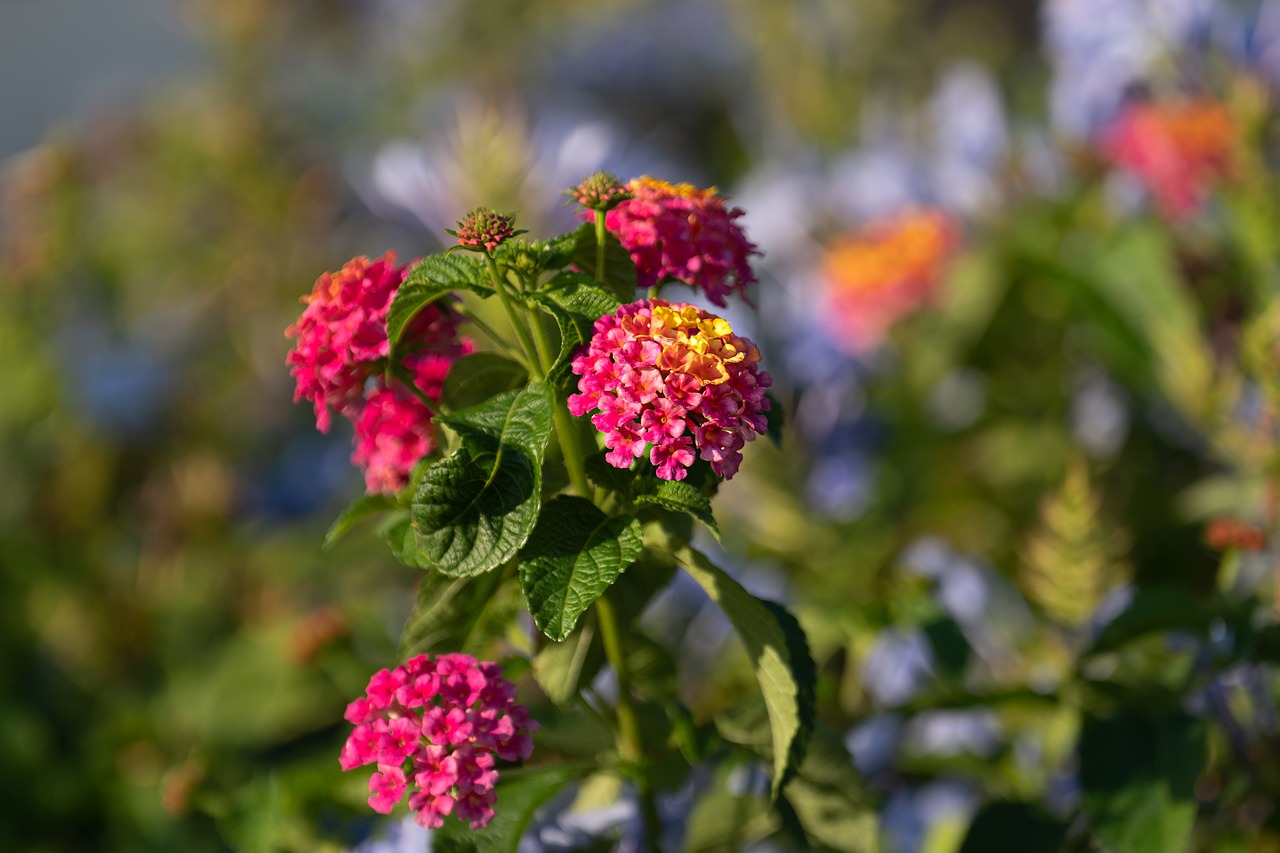
Lantana, a vibrant sun-worshipper with a kaleidoscope of blooms, is a favorite among gardeners. These cheerful perennials, or annuals in cooler climates, bring a fiesta of color and continuous flowering to borders, beds, and containers. But lantana isn’t a soloist; it thrives in a well-orchestrated duet with other captivating plants. Choosing the perfect companions elevates your lantana display from a charming melody to a breathtaking landscape symphony.
Sun-Kissed Harmony: Selecting the Right Companions
Sun Exposure: Lantana basks in the spotlight, demanding plenty of sunshine. Consider plants that revel in similar conditions to create a cohesive and thriving composition.
Water Wise Wonders: Lantana boasts impressive drought tolerance. Pair it with water-conscious companions for a low-maintenance haven.
Blooming Beauties: Extend the visual interest and create a dazzling display by selecting plants with complementary bloom times and colors.
Form and Function: Think about plant heights, textures, and growth habits to achieve visual balance and deter unwanted pests.
Best Lantana Companion Plants
Butterfly Bonanza: Lantana’s vibrant clusters are a butterfly magnet. Attract these fluttering friends with companion plants like:
- Coneflowers (Echinacea): These daisy-like perennials boast vibrant shades of purple, orange, and yellow, extending the bloom season and attracting even more pollinators.
- Milkweed (Asclepias): An essential food source for monarch butterflies, milkweed’s unique clusters and interesting foliage add another layer of intrigue.
- Russian Sage (Perovskia atriplicifolia): Aromatic and airy, Russian sage offers a stunning textural contrast with its spiky lavender flowers.
Complementary Color Splash: Lantana’s color palette ranges from fiery oranges and reds to calming yellows and purples. Play with color theory to create a masterpiece:
- For fiery lantana varieties: Cool things down with blue blooms like verbena or lavender. Salvia with its purple or white flowers is another excellent choice.
- For yellow lantana: Create a vibrant harmony with orange or red blooms like coreopsis, zinnias, or marigolds.
- For purple lantana: Lean into the elegance with white or silver foliage plants like dusty miller or artemisia. Yellow blooms like sunflowers or coreopsis can also add a touch of sunshine.
The Thrill of Textural Tapestry:
Don’t underestimate the power of texture! Intersperse lantana with plants that offer contrasting textures to add depth and visual interest to your garden:
- Flowing Grasses: Ornamental grasses like feather reed grass or pennisetum add a touch of movement and softness to the composition.
- Spiky Succulents: Echeveria with its rosettes or aloe vera with its upright form provide a unique contrast to lantana’s rounded blooms.
- Feathery Ferns: For a touch of shade and delicate texture, ferns like maidenhair fern or lady fern can be tucked in at the base of the lantana.
Beyond Blooms: Adding Contrast and Character
Fragrant Fancies: Introduce a delightful sensory experience by incorporating fragrant plants alongside lantana:
- Lavender (Lavandula): The calming scent of lavender complements lantana’s visual vibrancy.
- Night-Blooming Jasmine (Cestrum nocturnum): The intoxicating fragrance of night-blooming jasmine adds a touch of mystery to the evening garden.
Foliage Flair: Don’t let greenery be an afterthought! Plants with interesting foliage add year-round appeal:
- Purple Heart (Setcreasea purpurea): The deep purple foliage of purple heart creates a dramatic backdrop for lantana’s blooms.
- Variegated Liriope: The variegated stripes of liriope add a touch of whimsy and provide winter interest.
Vining Companions for Containers: Spilling lantana varieties thrive in containers. Complement their cascading beauty with:
- Sweet Potato Vine (Ipomoea batatas): The vibrant foliage of sweet potato vine adds a trailing element and comes in various colors to match your lantana.
- Million Bells (Calibrachoa): These tiny, trumpet-shaped blooms in a kaleidoscope of colors create a charming and overflowing display when paired with lantana.
Creating a Cohesive Masterpiece
Planning Makes Perfect: Before planting, sketch out your design on paper or use online garden planning tools. Consider the mature size of each plant and space them accordingly to avoid overcrowding.
Staggering Heights: Create visual interest by planting taller companions at the back of the border, followed by mid-height plants, and then let lantana cascade over the front.
Mulch Magic: Apply a layer of mulch around your plants to retain moisture, suppress weeds, and add a polished touch to your landscape symphony.
The Encore: Maintaining Your Lantana Masterpiece
Regular Deadheading: To encourage continuous blooming, deadhead spent lantana flowers by pinching them off just below the bloom head. This promotes new flower production and keeps your display looking fresh.
Water Wisely: While lantana is drought tolerant, it appreciates occasional deep watering, especially during extended dry periods. Aim for the soil to be moist but not soggy.
Feeding Frenzy: For optimal flowering, fertilize your lantana plants every 4-6 weeks during the growing season with a balanced fertilizer diluted according to package instructions.
Winter Wonders: In colder climates, lantana can be brought indoors as a houseplant over winter. Prune it back by about half and place it in a sunny location. Water it sparingly and enjoy its vibrant foliage throughout the winter months.
With careful planning and loving care, your lantana and its captivating companions will create a dazzling landscape symphony that will bring joy throughout the season. So get creative, experiment with different combinations, and let your garden become a vibrant expression of your unique
